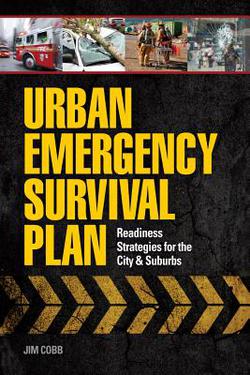One of my favorite authors, Jim Cobb, is at it again! This man is a veritable treasure trove of expert information that is not only practical and makes sense, he does so without fear mongering. His latest book, Urban Emergency Survival Plan is no exception to this man’s knowledge and dedication to helping people survive emergencies – whether natural or man-made!
If you have been following me for any length of time, you know I am kind of all over the board between homesteading and prepping for the unknown. There are very blurred lines between the two lifestyles and while I do not live in an urban area whatsoever, there is still incredible value to me in this book. Especially when it comes to dealing with other people’s actions and reactions to the disaster unfolding around them. There are certain aspects to human behavior that can pretty much be counted on (such as a fight or flight instinct) and here is where Cobb really outdoes himself. When there is a large scale emergency, more often than not it is your fellow man and neighbor that is more of a threat than the initial disaster itself. In a SHTF situation, food is usually the biggest motive for committing criminal acts against others. Food preservation and storage is a cornerstone of any preparing or survival plan. Many people face the problem of space to store everything and that is covered, too!
With his permission, here is an excerpt from Chapter 5 – Food Storage
Excerpt from URBAN EMERGENCY SURVIVAL PLAN, Chapter 5 – Food Storage
Where do I store all this stuff?
One of the difficulties with food storage in an urban or suburban home is your space may be severely limited. While nobody has truly unlimited storage room, no matter where they live, if you’re in an apartment or condo, you just aren’t going to have as much room as someone who has a full basement under their home.
Fortunately, there are several places in even the smallest apartment where you can squirrel away goodies for a rainy day, without turning your pad into something that looks like it should be featured on Hoarders.
Under the bed
The average can of soup or beans is about 3″ across. A queen-sized bed is 60″ x 80″, not counting the frame and headboard. A bit of fifth-grade level math tells us that you could fit roughly 500 cans of food under the bed. Of course, that will go down a little bit depending on how you store the cans, such as using a plastic tray or cardboard boxes. Even so, that’s a ton of food in a pretty small space. Depending on how high your bed sits off the floor, you might even be able to double-stack the cans. Risers, found at most big box retailers, raise the bed higher, allowing for more storage space underneath.
Granted, it isn’t the best idea to have the entire floor under your bed covered in canned food, if only because of the difficulty of reaching and rotating it all. However, let’s say you have one queen-sized bed and two double beds in your condo. You could put 300 cans of food under the queen bed and 150 under each of the doubles. That still gives you 600 cans of food!
Closets
Even the smallest of living spaces usually has at least one or two closets. Start by ditching the stuff in those closets that you really will never use again. The shoes that went out of style years ago would be a good start. Then, use the back wall of the closet for food storage. You could build shelves or install a prefabricated storage system. Really though, just stacking a few cases of canned goods on the floor will work fairly well.
Basements
Many apartment buildings allow tenants a small amount of storage space in the basement. Often, it isn’t a lot of space and it isn’t all that secure. But, even so, this is space you can use for food storage. What you might consider doing though is concealing the food from prying eyes. Rather than have your storage unit filled with cases that say Campbell’s Soup on the sides, repackage the cans in a box on which you’ve written something like, “Grandma’s shoes.”
If you go this route, be sure to keep the boxes up off the floor. Basements are, of course, notorious for having damp floors.
Hidden in Plain Sight
A large Rubbermaid tub, filled with food or supplies, then covered with a table cloth or fabric makes a nice coffee table, believe it or not. You can do the same with a taller box or a few smaller boxes stacked together and call it and end stand. Get creative!

As you can see, this book provides useful information that can be implemented immediately. This is only one section! He takes his years of experience and education and puts it into a language that is easy to understand. There is no fear mongering whatsoever – it is more like having a conversation with a friend who just happens to be an expert. 😉
I highly recommend this to everyone, regardless if you live rural or urban! I also reviewed another book of his, “52 Weeks to Preparedness.” You may also want to consider some of his other books that are found in both paperback and on Kindle!





Hey Jim – excellent article. I just got done reading an article that was focused on urban preparedness, specifically being ready for an emergency at work and needing gear to get home. We focus too much on Bug Out, and not enough on the disasters we don’t think about. If you care to, check out an article I posted on my site(link in my name) which includes some must-have survival books. I’m confident you own most of them. I’m going to check this book out that you’ve got listed here as well.
Great site!